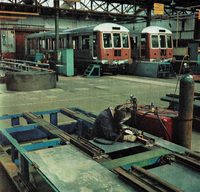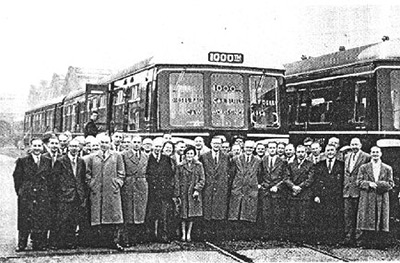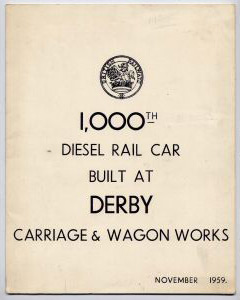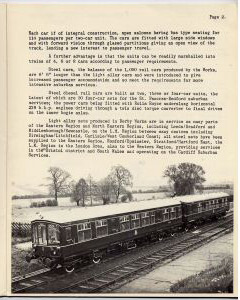Class 108 Derby 2,3 & 4-car DMUs
Orders
Some ordering details:
- The 1958 sets (with power cars in the 506xx series) were originally ordered from BRC&W but in mid-1956 this was changed to Derby Works. Noted in the minutes of the Diesel Lightweight Train Committee.
- in March 1958 the British Transport Commission (BTC) placed a £325,000 order with British United Transport (BUT), to provide engines, transmission and control equipment for 62 2-car sets (power / trailer sets 50938-87 / 56221-70, and power twin sets 50924-35 / 51561-72).
- in February 1959 the BTC ordered equipment for nine power/trailer sets (51416-25 / 56271-9) from BUT, together with the equipment for seven ScR Cross-Country sets and Class 127s.
Lots 30460 and 30461
This portion of a BR document shows that lot 30461 was originally intended to be built as driving trailers and allocated the numbers 56320-31.

It shows 56320-32 but I believe that is a typo as that would be thirteen vehicles, it notes there were twelve, and 56332 was on the document for another vehicle.
This change left a gap in the numbering series for the DTCs - there may have been more involved in the changes that involved lot 30460 to create the gap of 50936/7 (50936 later used when the quantites of Class 126 vehicles ordered changed).
Lot 30493

Vehicles under construction. Alloy bodyside panels are being welded in the foreground. The two vehicles have their sides still in unpainted alloy, the steel cab front is in red oxide primer - the alloy frames of the windscreens still unpainted. The cab roof domes are made in white glassfibre. Image courtesy of Mike Ashworth.
When vehicles have a lot number that differs greatly from their partners it is a suggestion that amendments to build plans have taken place. Lot 30493 was five trailer seconds (E59386 - 59390) that would be delivered as three-car sets with DMBS (E50620 - 50624) from lot 30406 and DMS (E50642 - 50646) from lot 30408, suggesting something changed.
Another indicator of changes is that identical vehicles were normally given different lot numbers depending on the formation in which they would be placed. As an example if we look at M50924-87, all identical diagram 543 vehicles, 50924-35 were formed into power twins and given lot 30460, the remaining vehicles would work with a driver trailers and allocated lot 30465.
If we look at E50599-50624, all lot 30406, most ran with driving trailers but the last five were in the three-car sets with lot 30493. I suggest that it is likely all were originally planned as driver trailer sets (E50599-50624 with E56190-56215), and the last five driver trailers were re-assigned as centre cars (lot 30493). If the five LMR driving trailer sets were originally to be M50625-9 with M56216-20, the DTC numbers could slide forward five places and create the number gap 56216-220. 56218-20 would then be taken up by Met-Camm vehicles.
Lots 30601, 30602 and 30660
At the February 18, 1959 meeting of the Lightweight Diesel Trains Committee it was noted that fifty two-car sets (motor car and trailer) were required in the 1960 build programme for St Pancras - Leicester, Nottingham - Leicester and Marylebone - Sheffield local services. These were to be built at Derby with a scheduled delivery date of September to December 1960. Ordered on March 20th 1959, by the April 29th 1959 meeting they were identified as Lots 30601/2 and the delivery dates were now noted as January 1960 to April 1961.
By the August 19, 1959 meeting the Manchester Part 3 scheme had become more of a priority and it was requested that 29 sets from Lots 30601/2 be built as power twins and transferred to that scheme, the replacements would be added to the 1961 build programme. The Committee approved the change at the next meeting on October 21st, 1959, and would seek the necessary authority for the additional cost (£197,200). An appendix to the same meeting showed that although the vehicles had been switched to power cars at this stage they were still allocated their original numbers (Lot 30602 56484 - 56533) and that only three sets would be for the Manchester Part 3 scheme, fifteen would be for the Manchester Part 4 scheme and 11 for the North Wales Part 3 scheme (Wrexham - Chester - New Brighton).

The British Transport Commission approved the expenditure for the change by the December 30 1959 meeting, the 29 DMCLs have an order date of 31/12/59 and they were allocated Lot number 30660 (becoming 52037-65).
1000th vehicle

Vehicle 51562 (DMC) was the 1,000th DMU car to be built by Derby. They held a short ceremony to celebrate the fact on 4 November 1959. It was also the 414th lightweight aluminium car to be built. The works manager, AE Bates congratulated representative staff members concerned with the railcar construction.
The event can be seen in a film clip on the Media Archive for Central England website.
A special booklet commemorating the event was produced, a couple of pages are shown here.


The vehicle entered service at Chester depot mainly operating on New Brighton services, it was still carrying sideboards noting it was the "1000th Diesel Railcar Built At Derby Carriage & Wagon Works" in 1966.
The vehicle was preserved by the National Railway Museum.
France
A 2-car set visited Strasbourg for an exhibition of aluminium rolling stock on June 20-25th 1960. The DTC vehicle was displayed as a shell, without any interior fittings or panelling whatsoever, so that the bodyside, roof and floor construction, and the layout of conduits and piping could be seen in full. It attracted much attention and led to lengthy discussions. The power car, 52045, was a completed vehicle. All the vehicles for the exhibition (a 16 ton mineral wagon, a 21 ton hopper wagon, an experimental aluminium container, a London Transport Executive District Line car and a British Railways box wagon loaded with aluminium components) were marshalled into a train and crossed the channel on the Dover - Dunkirk train ferry on the 11th June.
Summary
Orders
Description
Works Photographs
Modifications
Refurbishment
Diagrams
Numbering & Driving Inst.
Liveries
Operations
- Scotland
Accidents
Decline
Non-Passenger Use
Images
Details about preserved Class 108s can be found here.


